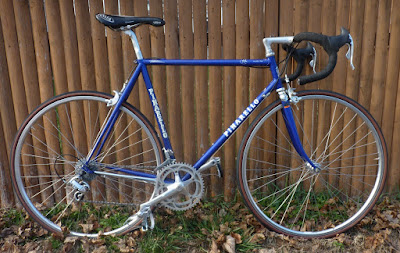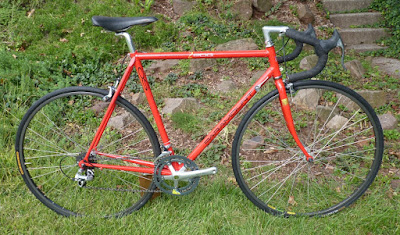(The title is a song reference from all-time favorite musician,
Jason Falkner.)
When discussing
bicycle sizes I have often explained to people that I feel comfortable on bikes
anywhere in the 53-57 centimeter range. Because I am rather long in the torso,
I can make a low saddle adjustment and use the longer frames to my reach advantage.
With a higher saddle adjustment and a longer stem, the smaller frames can also
feel very comfortable.
I was under the
impression that my Pinarello (photo left) had a 55 cm frame, as that was the measurement
given by the person who sold it to me. I had no reason to think differently, as
it appeared to be of similar size to others in my collection and is the most
comfortable to ride of the bunch. However, when someone inquired about the
dimensions of the white FP2 frame I was selling, I found myself consulting an online
Pinarello geometry chart and discovered I had been deceived.
The complication
arises from the fact that many modern frames have a sloped top tube, which
renders the traditional seat tube measurement useless. A more accurate method
of measurement would be to provide what I like to call “A-line” length. Looking
at the diagram below, the “A-line” would be an imaginary line drawn from the
center of the top tube/head tube junction, parallel to the ground where it
would intersect the center of an extended seat tube – a representation of the location
of a traditional top tube.
By looking at the
Pinarello geometry chart and taking some measurements, I confirmed that my FP2
is, in fact, a 53 cm! I then began to consider my other bicycles, and if there
were any changes I would want to make to more closely duplicate the comfort
level of the Pinarello. The Colnago (56 cm) has always been a dream bike of mine
and has wonderful proportions, so it is a definite “keeper”, although I am now
considering a shorter stem to relax the reach a bit. My Bianchi ‘cross bike is
also a 56 and has upright bars, so it has no comfort issues to speak of.
 I had been working
on so many red bicycles lately, I had considered throwing a bit more color into
my collection and ditching the Saeco-Cannondale replica bicycle (photo right). I didn’t like
its proportions as much as my other bikes, and it had quite an inferior
component group, although I pointed out to my wife that I had tuned up its
drive train so well that it ran quieter than any of rest of my bikes! The low-end
components had made the bike very affordable at the time of purchase.
I had been working
on so many red bicycles lately, I had considered throwing a bit more color into
my collection and ditching the Saeco-Cannondale replica bicycle (photo right). I didn’t like
its proportions as much as my other bikes, and it had quite an inferior
component group, although I pointed out to my wife that I had tuned up its
drive train so well that it ran quieter than any of rest of my bikes! The low-end
components had made the bike very affordable at the time of purchase.
Turns out the
Cannondale should have been even more
affordable, had I again not received incorrect information from the seller.
Back when I bought
this bike, it was listed as a R2000 Si, and I had no reason to believe
otherwise, as the picture of the bike looked exactly the same as others I found
on sites like BicycleBlueBook and BikePedia. Some of the components were
different, but offering a frame with lower level parts isn’t an unusual
practice for bike shops attempting to sell at a lower price point.
When I eventually
decided to sell this Cannondale, I met a gentleman who was VERY thorough – in
fact, he took about a half hour to look it over, tweak things and take a little
test spin around a nearby parking lot. He was struggling with the decision and
told me his wife was going to inspect the bike just as closely when he got
home. After much deliberation, he agreed to my asking price, and I figured that
he was satisfied with everything.
I really shouldn’t
have been surprised when I received a call from him a couple of days later. His
wife was getting on his case about the money he had spent, and he started a
little investigating. It turns out that Cannondale made an R700 - an identical
bicycle of a bit lower quality, which turned out to be the actual model of the
one I sold. Ignoring the fact that I had made some upgrades, he was claiming I
made some misrepresentation of the bike for sale. I told him that I had never
seen anything about the R700, but agreed, after looking closely at the specs, that
he was totally correct in its identification!
I definitely didn’t
want him to think that I deliberately listed the wrong model bike, and I wanted
him to be happy with his purchase. I really want customers to spread a good
word about doing business with me, so I quickly agreed to send him a partial
refund for the difference in value between the two bicycles.
This all leads up
to the purchase of my like new 2013 CAAD10 bicycle. I briefly considered a
carbon fiber Cannondale, but I already have a carbon bike that I love, so I
thought a better move would be a purchase of the latest in aluminum frames (although Cannondale just came out with
the CAAD12, for some reason skipping the number 11). This time I would purchase
a 54 cm to more closely match the fit of the FP2.
I had initially bought
a 2012 CAAD10 in Cannondale team colors with Shimano 105 components via eBay,
but the (honest) seller contacted me the next day to let me know he had discovered
a dent under the top tube during packaging. Since he had listed it “like new”,
he felt he should check before shipping to make sure that I still wanted to go
through with the purchase. With my recent run of bad luck, I really wanted no
part in buying a damaged bicycle, so I requested the refund.
This turned out to
be a really fortuitous event, since I had seen on craigslist a newer version of the bike with
a bit more splash of color. I had actually made an offer on this
bike a week before the eBay purchase and had been turned down, with the seller
citing some other buyer. This transaction must have fallen through, and the
seller was more willing to go with my price the second time around.
I did want to swap
out a compact crankset and found a very lightly used version that matched the
existing components, and the one that came on the bike had seen less than 200
miles (according to the seller), so it should be an attractive re-sell item!
The parts came Thursday, so I was able to take the bike out for a test ride on
Friday afternoon.
I didn’t have a
particularly good riding experience, feeling a bit fatigued when I finished. By
my regular standards, I hadn’t gone on a very long route, but something just
didn’t feel right - I wasn’t sure if further adjustments needed to be made or
if the general ride quality was poor. I did have a bad night of sleep the night
before and wondered if that was also part of the equation.
We had an unbelievably warm December day on
Sunday, so I chose the Pinarello for a long ride (in shorts and short-sleeves!),
but I definitely wanted to get back to the Cannondale for my ride today. I made
sure to be more attentive to all aspects of the experience this time around.
I was amazed at
first to find that the two bikes were very similar in weight – had it not been
for the carbon components and wheelset on the FP2, I probably wouldn’t be able
to tell the difference lifting each up with my eyes closed! I decided to take
the CAAD10 out on a hilly route today, and the stiff aluminum frame really shone
on such terrain. There is absolutely no flex when standing on the pedals –
perfect power transfer!
However, I do think the CAAD10 feels a bit
harsh on the not-so-smooth PA roads. Although I am used to the plusher feel of
cork bar tape and a slightly bigger diameter bar tubing on some of my other
bikes, I don’t think the problem is up front. The bike has a carbon fork to
absorb vibration, and I didn’t feel changing up hand positions was any more
necessary than usual.
The technology has
improved enough in manufacturing the aluminum alloy, that the extremely over-sized diameter downtube that was once a trademark of the Cannondale design is no longer necessary. This change definitely results in weight reduction, but I’m
not sure some vibration dampening wasn’t eliminated at the same time. The rear
stays are also spindlier, and they lack the bowed-in shape (photo left) of earlier
Cannondales, which I’m sure had provided a bit of flex over bumps.
Maybe I’ve been
spoiled overall by the ride quality of my bikes through the years, but it might take a bit
of time to get used to this Cannondale. Merry Christmas and Happy New Year!





















































